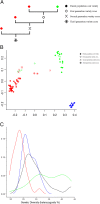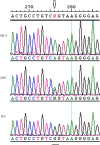Heterozygosity testing and multiplex DNA panel screening as a potential tool to monitor health and inbreeding in a small, closed dog population
- PMID: 30607250
- PMCID: PMC6309085
- DOI: 10.1186/s40575-018-0068-6
Heterozygosity testing and multiplex DNA panel screening as a potential tool to monitor health and inbreeding in a small, closed dog population
Abstract
Background: Selective breeding in populations with a limited effective population size may result in a loss of genetic diversity, which can cause an increased concentration of specific disease liability genes. The Dutch Shepherd Dog (DSD) in the Netherlands is an example of such a breed with a small effective population.
Objective: To evaluate the measurement of genetic diversity and multiplex DNA panel screening for implementation in a breeding strategy for the Dutch Shepherd Dog (DSD) and to investigate the clinical relevance of potentially identified mutations in the multiplex DNA panel screening.
Results: Genome-wide SNP testing showed genetic isolation and reduced genetic diversity within coat variety subgroups of the DSD. Panel screening identified a Von Willebrand's Disease type I mutation. Although decreased Von Willebrand's Factor proteins were significantly lower in DSDs carrying the VWD-I allele compared to the wildtype, clinical follow-up did not show a significant association between the clinical phenotype and VWD-I genotype.
Conclusions: Genetic relationship measurement within a breed population may be a useful tool to enable breeding strategies to conserve genetic diversity. Results from a disease panel screening need to be evaluated for clinical relevance before breed selection restrictions can be considered.
Keywords: Canine health; Dog breeding; Dutch shepherd dog; Genetic disorder; Heterozygosity; MyDogDNA™; Von Willebrand’s disease.
Conflict of interest statement
Samples were collected with the informed consent of the owners.Not applicable.HA and JD are employees of Genoscoper Laboratories Oy, developer of the MyDogDNA™ screening service. “The aforementioned authors played no role in the decision to conduct the study or use the MyDogDNA™ genotyping platform, the original study design, or writing of the original manuscript draft.”Springer Nature remains neutral with regard to jurisdictional claims in published maps and institutional affiliations.
Figures




Similar articles
-
Variation in breeding practices and geographic isolation drive subpopulation differentiation, contributing to the loss of genetic diversity within dog breed lineages.Canine Med Genet. 2020 Jun 9;7:5. doi: 10.1186/s40575-020-00085-9. eCollection 2020. Canine Med Genet. 2020. PMID: 32835230 Free PMC article.
-
Genetic Panel Screening of Nearly 100 Mutations Reveals New Insights into the Breed Distribution of Risk Variants for Canine Hereditary Disorders.PLoS One. 2016 Aug 15;11(8):e0161005. doi: 10.1371/journal.pone.0161005. eCollection 2016. PLoS One. 2016. PMID: 27525650 Free PMC article.
-
Von Willebrand's disease in the German shepherd dog.J S Afr Vet Assoc. 2000 Jun;71(2):118-21. doi: 10.4102/jsava.v71i2.693. J S Afr Vet Assoc. 2000. PMID: 11030365
-
Canine von Willebrand's disease. A heterogeneous group of bleeding disorders.Vet Clin North Am Small Anim Pract. 1988 Jan;18(1):195-229. doi: 10.1016/s0195-5616(88)50017-7. Vet Clin North Am Small Anim Pract. 1988. PMID: 3282380 Review.
-
Management of canine von Willebrand's disease.Probl Vet Med. 1992 Dec;4(4):636-46. Probl Vet Med. 1992. PMID: 1472774 Review.
Cited by
-
Genetic prevalence and clinical relevance of canine Mendelian disease variants in over one million dogs.PLoS Genet. 2023 Feb 27;19(2):e1010651. doi: 10.1371/journal.pgen.1010651. eCollection 2023 Feb. PLoS Genet. 2023. PMID: 36848397 Free PMC article.
-
Variation in breeding practices and geographic isolation drive subpopulation differentiation, contributing to the loss of genetic diversity within dog breed lineages.Canine Med Genet. 2020 Jun 9;7:5. doi: 10.1186/s40575-020-00085-9. eCollection 2020. Canine Med Genet. 2020. PMID: 32835230 Free PMC article.
-
Development and validation of animal variant classification guidelines to objectively evaluate genetic variant pathogenicity in domestic animals.Front Vet Sci. 2024 Dec 5;11:1497817. doi: 10.3389/fvets.2024.1497817. eCollection 2024. Front Vet Sci. 2024. PMID: 39703406 Free PMC article.
-
The German Shorthair Pointer Dog Breed (Canis lupus familiaris): Genomic Inbreeding and Variability.Animals (Basel). 2020 Mar 17;10(3):498. doi: 10.3390/ani10030498. Animals (Basel). 2020. PMID: 32192001 Free PMC article.
-
Microsatellite DNA Analysis of Genetic Diversity and Parentage Testing in the Popular Dog Breeds in Poland.Genes (Basel). 2021 Mar 26;12(4):485. doi: 10.3390/genes12040485. Genes (Basel). 2021. PMID: 33810589 Free PMC article.
References
-
- Fédération Cynologique International. Breed nomenclature. Available at: http://www.fci.be/en/nomenclature/DUTCH-SHEPHERD-DOG-223.html.
-
- Dutch Shepherd Dog Club. Breed description. Available at: http://www.hollandseherder.nl/details/the_dutch_shepherd/.
LinkOut - more resources
Full Text Sources
Molecular Biology Databases

